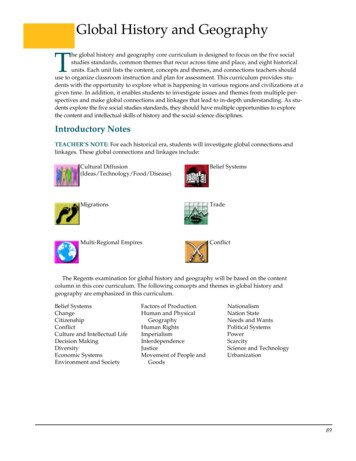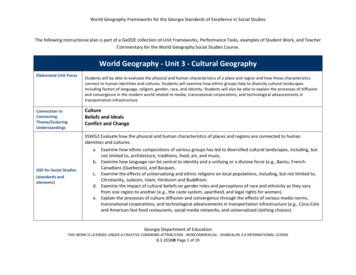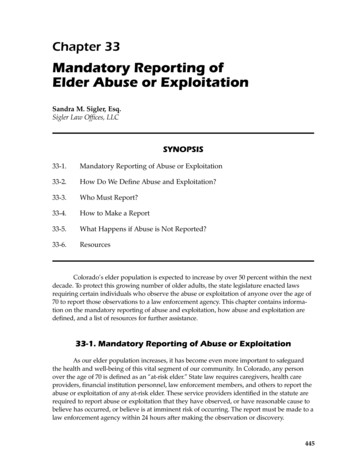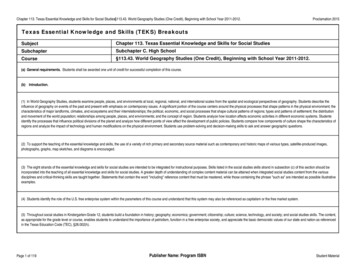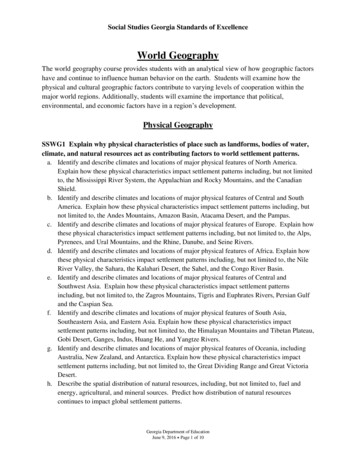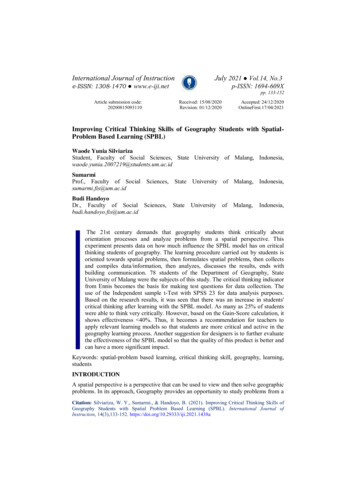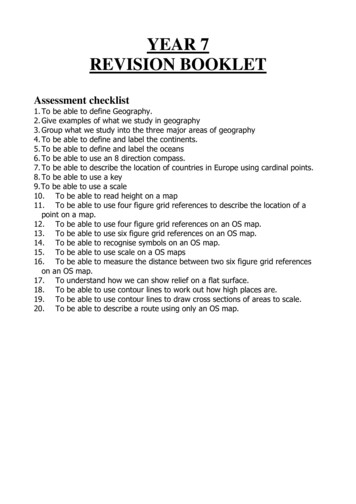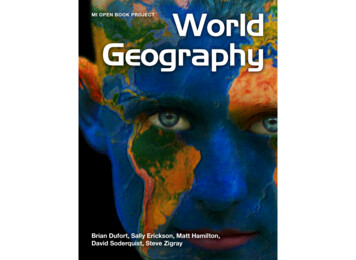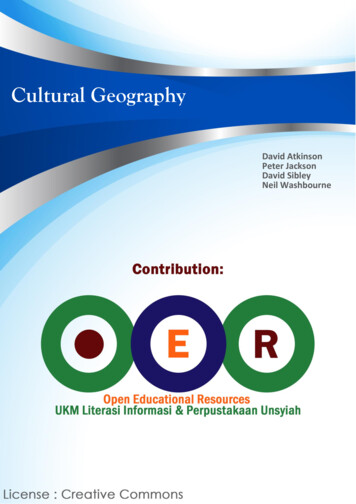
Transcription
Cultural GeographyDavid AtkinsonPeter JacksonDavid SibleyNeil Washbourne
Cultural Geography
Cultural GeographyA Critical Dictionaryof Key ConceptsEdited byDavid AtkinsonPeter JacksonDavid SibleyNeil Washbourne
Published in 2005 by I.B.Tauris & Co Ltd6 Salem Road, London W2 4BU175 Fifth Avenue, New York NY 10010www.ibtauris.comIn the United States and Canada distributed by Palgrave Macmillan,a division of St. Martin’s Press, 175 Fifth Avenue, New York NY 10010Copyright David Atkinson, Peter Jackson, David Sibley and Neil Washbourne, 2005The rights of David Atkinson, Peter Jackson, David Sibley and Neil Washbourne tobe identified as the authors of this work has been asserted by them in accordancewith the Copyright, Designs and Patents Act 1988.All rights reserved. Except for brief quotations in a review, this book, or any partthereof, may not be reproduced, stored in or introduced into a retrieval system, ortransmitted, in any form or by any means, electronic, mechanical, photocopying,recording or otherwise, without the prior written permission of the publisher.International Library of Human Geography 3ISBN Hardback 1 86064 703 0Paperback 1 86064 702 2EAN Hardback 978 1 86064 703 1Paperback 978 1 86064 702 4A full CIP record for this book is available from the British LibraryA full CIP record for this book is available from the Library of CongressLibrary of Congress catalog card: availableTypeset in Ehrhardt by Dexter Haven Associates Ltd, LondonPrinted and bound in Great Britain by MPG Books Ltd, Bodmin
ContentsEditors’ Preface: On Cultural and Critical GeographiesviiPART I: SPACE, KNOWLEDGE AND POWERIntroduction3Post-structuralismUlf Strohmayer6RepresentationOla Söderström11Positionality/Situated KnowledgeIan Cook et al.16Mapping/CartographyDenis Cosgrove27Travel/TourismMike Crang34Space/PlacePhil Hubbard41LandscapeDon Mitchell49EnvironmentSally Eden57GeopoliticsGearóid Ó Tuathail/Gerard Toal65GovernanceAndrew Jonas andAidan While72FlexibilitySuzanne Reimer80PART II: DIFFERENCE AND BELONGINGIntroduction89The BodyRobyn Longhurst91IdentityJames Martin97
GenderPeter Jackson103WhitenessAlastair Bonnett109(Dis)abilityRobert Wilton115SexualityMark Johnson122Moral GeographiesTim Cresswell128CitizenshipDarren O’Byrne135HeritageDavid Atkinson141PART III: BORDERS AND BOUNDARIESIntroduction153Private/PublicDavid Sibley155Globalisation/GlobalityNeil Washbourne161PostmodernismSteven Flusty169Colonialism/PostcolonialismAlison Blunt175DiasporaAnne-Marie Fortier182HybridityKatharyne Mitchell188Nature/CultureSteve Hinchliffe194Socio-technicalNick Bingham200Cyborg CulturesJudith Tsouvalis207Contributors213Index215
— Editors’ Preface —On Cultural and Critical GeographiesCultural geography is an exciting, lively and diverse field, the energy and vitalityof which is indicated by our decision to pluralise the term in this editorial preface.Cultural geographies, as currently practised, are now much wider in scope thandevelopments within a single branch of human geography. As the essays that followmake clear, cultural geographers now routinely engage with complex but importantquestions about social processes such as identity formation, the construction ofcultural difference, citizenship and belonging. These processes also challenge ourunderstanding of such core geographical categories as space and place, landscapeand environment, public and private. But cultural geographies, we argue, also linksuch ideas and imaginations with our changing material world. They allow us toexplore how these processes are affected by increased mobility, by changes inour socio-technical environment, and by other forces that are transforming theestablished notions of the relationships between nature and culture. As several ofthe following chapters reveal, cultural geographies are also engaging with politicaland economic ideas about governance and flexible accumulation as the boundariesbetween former sub-disciplines such as cultural and economic, social and politicalgeography, are increasingly transcended. Indeed, through its engagement with socialand cultural theory, the entire field of cultural geography has been transformed, andits recent developments have prompted the rethinking of many key concepts inhuman geography and beyond. In addition, there are now many other social scientistsas well as geographers ‘doing’ cultural geography (as contributors to this bookthemselves confirm).The diversity of cultural geography defies easy definition. For example, the recentHandbook of Cultural Geography elected not to define the field but, rather, describedcultural geography as an unruly affair best understood as a ‘style of thought’,without clearly identifiable boundaries, characterised by the valid and urgentquestions that it seeks to ask (Anderson et al. 2002, xiii–xiv). In more conventionalterms, it suggests that cultural geography addresses issues of distribution (wherethings are and why); ways of life; systems of meaning; questions of practice; andvii
C U LT U R A L G E O G R A P H Ynotions of power. In this collection we take a similar approach: allowing theindividual essays and their authors to define the field, since more formal definitionsimmediately lead to problems of closure and exclusion. We would rather think ofthe essays that make up this creative and fuzzily bounded collection of culturalgeographies as open-ended and post-disciplinary. This is reflected in theirauthorship: although the contributors to this volume have disciplinary identitiesincluding social anthropology, sociology, cultural studies and human geography,they are all producing cultural geographies and, in the process, they demonstratetheoretical convergences as well as refreshing differences in perspective.Yet one thing we did encourage from our contributors was a critical perspectiveon cultural geographies. By engaging with aspects of social relations, withconnections between people and the material world, and between culture andnature, the authors raise questions that are central to human well-being, but thatare also political. Since cultural geographies are embedded in the politics of ourcontemporary world, inevitably this collection is avowedly critical in places. Severalessays deal with questions of cultural difference, for example, a characteristic ofsocieties for which, as Joel Kahn (1995, 125) has argued, we now have ‘a consumingand erotic passion’. But, while cultural difference is celebrated in some realms, wemust also acknowledge that difference becomes politicised when providing groundsfor genocide as well as for routine, everyday oppression (as the recent history of theformer Yugoslavia and Rwanda demonstrates). The political is often inescapable,and our authors reflect upon a range of political issues, such as the changingrelationships between public and private space, anxieties about surveillance andthe intrusion of the state into private lives, the connections between culture andnature, and environmental crises. Given the ways that power is embedded throughoutsociety, we suggest that, in their theoretical articulation and in their engagementwith social relations and questions of human well-being, cultural geographies –above all else – must be critical.Although the re-invigoration of cultural geography in the early 1980s bore amarked critical edge (Cosgrove 1983, 1984; Cosgrove and Jackson 1987; Daniels1989), the relationship between cultural geographies and a politicised perspectivehas proved controversial more recently. Some argue that cultural geography haslost its original critical impetus and plead for a more politicised agenda (Mitchell2000). For others, the intangible subject matter of some cultural geography hasdiminished the relevance of human geography more generally, particularly whenaddressing practical social issues (Hamnett 2003; Storper 2001). Sympathetic voicesworry that certain strains of social and cultural geography lose sight of the materialgeographies that underpin social worlds (Philo 2000; Jackson 2000; cf. Andersonand Tolia-Kelly 2004), while, as several authors highlight, the politics of actuallydoing critical geography varies markedly around the world (Garcia-Ramon et al. 2004;Sundberg 2005). Although far from conclusive, this debate draws attention to therelations between cultural geographies, socio-political contexts, and the politics ofthe knowledge we produce, disseminate and consume. And, because the history ofcultural geography, as we understand it, has a substantive and enduring strain ofviii
P R E FA C Ecritique, this collection seeks to explore the critical concepts in cultural geographyfurther. In this respect, the book’s subtitle uses the term ‘critical’ in two ways. First,it addresses as ‘critical concepts’ those that are fundamentally important to theemergence and form of cultural geography, those that provide the foundation andbuilding blocks of our contemporary work in this area. Second, it refers to the‘critical’ in terms of critique. The book serves both these meanings, but, as thesecond is more contentious, the rest of this introduction explores the potential for‘critical’ perspectives in relation to the production of cultural geographies.I N W H AT S E N S E ‘ C R I T I C A L’ K N OW L E D G E ?The project of developing ways of thinking critically (and reflexively) about theproduction of knowledge has a long and contested history that draws upon varioustheoretical perspectives and political alignments, including Marxist, feminist,postcolonial and post-structural thinking. Some of these are relatively recentdevelopments, some have histories stretching back at least to the nineteenth century.Thus, given the sometimes contradictory and overlapping nature of these areas ofthought, no simple chronology or delineation of a discrete theoretical territoryis possible. Consequently, from the start of this project we recognised the decentredness of knowledge in the human sciences and the ‘blurred genres’ thatClifford Geertz has identified as characteristic of social thought (Geertz 1980). Inthe intervening years, feminism in particular and post-structuralism more generallyhave opened up the humanities and social sciences by challenging masculinisedknowledge and claims to universal ‘truths’ (in geography, see McDowell and Sharp1999; Rose 1993). In fields such as social anthropology this process has been takenfurther. Laura Nader (1996, 1–2), for example, cites the writing of the YupiaqAlaskan Oscar Kwagley, who recalls that ‘his great grandparents forbade hisgrandmother from attending school, saying that she would become dumb’. Theyfeared that ‘Western knowledge’, imparted in Native Alaskan settlement schools,would erase indigenous knowledge. In refusing to use the school, the parents wereresisting (neo)colonialism and rejecting assumptions about the superiority of Westernknowledge hierarchies. A similar scepticism towards knowledge hierarchies alsoinforms this book.This collection is offered more in the spirit of Raymond Williams’ Keywords(1976) than in the style of orthodox dictionaries of ‘key concepts’. We make noattempt to be comprehensive in terms of coverage, to be definitive, or to providethe last word on any issue. Rather, borrowing from Williams’ concept of ‘fields ofmeanings’, we attempt to show how some of the words, phrases and concepts weuse in our everyday communication and in our academic work are invested withcomplex meanings that change with different contexts of use and reception, and thatreflect different geographical and historical circumstances. We also share Williams’commitment to debate, to plurality, and to the cut and thrust that characterise thecontemporary social science that defines itself as ‘critical’.ix
C U LT U R A L G E O G R A P H YThough Williams is a crucial reference point for discussing interrelated criticalvocabularies, we should note some divergences of our project from his. For him,five words were central: ‘culture’, ‘art’, ‘class’, ‘industry’ and ‘democracy’, forming‘a kind of structure’ (11) for the whole enterprise. We have not prioritised any ofour concepts, treating each in similarly critical terms. For Williams, the frame ofreference provided ‘the record of an inquiry into a vocabulary: a shared body ofwords and meanings in our most general discussions, in English, of the practicesand institutions we group as culture and society’ (13, italics in original). This dependsupon assumptions about the singularity of ‘English’ identity (literature, society,culture) that today seem highly questionable. Nevertheless, Williams’ projectprovides a helpful template, and this collection explores key ‘fields of meanings’ incultural geography, but with a critical inflection. Therefore, before we go any further,we want to outline and contextualise what ‘critical geography’ has come to meanwithin Anglo-American academia.THE MAKING OF CRITICAL GEOGRAPHIESAlthough the last few years have seen ‘critical geography’ increasingly embedded atthe heart of Anglo-American human geography, this tradition draws upon an earliergeneration of radical geographies that, while centred upon Marxism, also had arange of other inspirations, including anarchism, feminism and environmentalism.Radical geography in the 1970s was articulated in opposition to the dominance ofspatial science in human geography, and in sympathy with wider political processesof the period (such as the American Civil Rights movement, the global studentprotests of 1968, the women’s movement and other forms of radical politics). Amidstall this, and galvanised by books such as David Harvey’s Social Justice and the City(1973), Richard Peet’s Radical Geography (1977) and the journal Antipode, academicgeographers began to question the workings of power and authority within society– exploring how capital and the state produced unequal development at various scales,and what roles geography played within these processes. What these initiativesshared was a keen sense of the politicisation of societies and everyday lives and,concomitantly, that the spatial and geographical constitution of social life gavegeography and geographers an active, if not activist, role in interrogating socialprocesses.One of the first uses of the term ‘critical human geography’ was as the title ofa series of geography textbooks in the 1980s, which included Doreen Massey’sSpatial Divisions of Labour (1984) and Derek Gregory and John Urry’s SocialRelations and Spatial Structures (1985). Here ‘critical’ referred to the school of‘critical theory’ associated with Jurgen Habermas. His work explored the connectionsbetween different forms of knowledge and the political interests they served. Ittried to establish a link between positivist (empirical–analytic) science and thelegitimation of various structures of domination; between historical–hermeneuticscience and the improvement of human self-understanding; and between ‘critical’x
P R E FA C Esocial science and human emancipation. While it may have fallen short of theseambitious goals, the Critical Human Geography series did help to reconnect humangeography with other humanities and social sciences, to bridge the gap betweensocial theory and empirical research, and to address the political implications ofgeographical knowledge. It promoted an argumentative style, based on originalresearch, rather than a bland synthesis of existing material. It also claimed toengage readers in the project of developing ‘a genuinely human geography’. Theseinnovative objectives foreshadowed agendas that remain central to ‘critical geography’today.The questions and intellectual frameworks of geographers changed appreciablythrough the 1980s and 1990s as the wider political context was transformed. Thecollapse of communism in Europe, the end of apartheid in South Africa and theemergence of new challenges to the West from so-called ‘rogue states’ all fracturedearlier assumptions about the world order. Human geographers were forced toconceptualise the world anew – adapting an increasing range of theoreticalperspectives in the process (Peet and Thrift 1989). Likewise, globalisation alsoprompted the shaping of a critical human geography. Popular resistance to theeconomic and environmental policies of the GATT nations (epitomised by the 2000‘Battle for Seattle’), and towards the corporate ethics and practices of contemporaryflexible capitalism, fuelled critical research, as did continuing global inequalities,poverty and hunger (Smith 2000). The fraught politics of the Middle East, thetraumatic events at the World Trade Center on 11 September 2001, and the 2003invasion of Iraq also demanded analysis (Gregory 2004). For many, these are starklygeographical phenomena, and our contemporary world calls for geographers toengage with its changing structures and challenges (see Johnston et al. 2002).Throughout this period, human geography became more politicised through thearticulation of a specifically critical agenda.At the same time critical geography is also intensely embroiled in ‘culturalpolitics’. Within the academy there is widespread recognition that cultural activitycannot be divorced from social, political and economic forces; that ‘culture’ is itselfa site of struggle (cf. Mitchell 2000). The production of knowledge (includingacademic practices such as creating books – this one included) clearly involvesaccess to material and intellectual resources. It has its own established hierarchiesand conventions, centres of excellence and marginalised sites, often defined interms of racialised, gendered and class-based exclusions (Sibley 1995). Despitesome concerns that contemporary cultural geography might lose sight of keyissues such as inequality, exclusion and universal citizenship, there is much to besaid for geography’s reflexive recognition of the cultural politics of everyday livesand labours. Acknowledging how social groups construct and negotiate their lifeworlds has further de-centred traditional, masculinist geographical gazes (Rose1993) and necessitated new ways of approaching the political and the critical. Inturn, this has further influenced the development of cultural geography.At a more parochial level, the interrelation of global events and the culturalpolitics of the academy are illustrated by a recent debate within British geography.xi
C U LT U R A L G E O G R A P H YThe proposed merger of the university-based Institute of British Geographers(IBG), with the more broadly based Royal Geographical Society (RGS) – seen bymany academics as a conservative body still tainted by its connections toimperialism (Driver 2001) – raised broader questions about the politics ofgeographical knowledge. A fierce debate erupted in 1995 over one of the newlymerged RGS–IBG’s corporate sponsors. The multinational oil corporation Shellhad affiliated itself with the RGS in the interests of promoting environmentalawareness. Its critics perceived a strategy of deflecting attention from the company’sown environmental record. In 1995 the corporation attracted intense internationalcriticism for the damaging environmental impacts of its oil extraction on theOgoni delta in southern Nigeria, and for its alleged collusion in the persecution oflocal resistance. In particular, Shell was accused of complicity with the suddenarrest, trial and execution in November 1995 of Ken Sara-Wiwo, a leading Ogoniwriter and environmental activist (Watts 1997, 2001). Although Shell denied thecharges, for academics committed to highlighting environmental damage andexposing the workings of power, Shell’s corporate sponsorship of their professionalorganisation was untenable. Many resigned (Gilbert et al. 1999). Of course,geographers’ corporate affiliations are of minor relevance amidst wider global events,but for many academics the ‘Shell debate’ crystallised the ethics of academicknowledge production and its uses, and further prompted a shift towards a criticalgeography.Such disputes also helped define the project’s central goal of interrogating thesocial world. As Trevor Barnes and Derek Gregory wrote (1996, 8):a truly critical human geography [exposes] the taken-for-grantedness of everydaylife how the worlds which we inhabit are the products of processes operatingover varying timescales whose outcomes could have been different: thus there isnothing inevitable about the [world or its] processes operating over varyinggeographical scales which join our lives to those of countless others.Developing critical theories is thus a key concern of this field – although this alsodemands reflexivity about our own positionality and pedagogies (Castree 2000),and a more internationalist outlook in our work (Painter 2000). For some, criticalgeography also entails more practical engagements with the world through thelinking of ideas and practices, and through confronting ‘the exercise of power ata range of scales, and well beyond academia’ (Katz 1998, 257). It encompassesan opposition to unequal and oppressive power relations and a commitmentto transformative politics and greater social justice. It promotes closer relationshipsbetween theory and practice, and to pursuing the links between politics inside andoutside the academy (Desbiens and Smith 1999; Painter 2000). In this vein, criticalgeography pursues a political as well as an academic agenda, encouragingparticipation from, and communication between, local activists and campaign groupsas well as from academics (Desbiens and Smith 1999). For Cindi Katz (1998),reflecting on the inaugural 1997 International Conference of Critical Geographers,this initiative was about an ‘oppositional geography’ producing theory and practicexii
P R E FA C Ethat cross borders to bring about greater social justice, equality and selfdetermination at all scales.Productive debate about the meanings, extent and purpose of criticalgeography continues (Garcia-Ramon et al. 2004). Hopefully, the loose and inclusivenature of critical geography allows space for all these concerns – whetherindividuals interrogate the social world theoretically, focus upon academic practiceand pedagogy, or engage with activism. Certainly, as we write, ‘critical geography’has become a self-conscious label signifying a commitment to some or all of theseelements.CRITIQUING CRITICAL GEOGRAPHIESWhile we find these developments refreshing and productive, there are, of course,potential problems. The label ‘critical’ in academic work (including this book)implies that other geographers, past or present, approach their work uncritically – andthis potential arrogance runs counter to the moving spirit of ‘critical geography’.Our use of (plural) geographies indicates our recognition of the many ways of beingcritical. The danger of over-privileging any perspective within ‘critical geography’demands reflexivity in the term’s use. At the same time, ‘critical geography’ hasrapidly become one of the key identifying labels within contemporary humangeography. Academic articles, books and university posts have all been positionedwithin the frames of ‘critical geography’, threatening to institutionalise and normatiseit within established academic structures and, by extension, threatening to diluteits critique.A related threat to critical geography’s purposes is the emergence of a tightlydefined school of critical geography. The ‘Chicago school’ in sociology, or the‘Vidalienne’, ‘Los Angeles’ and ‘Berkeley’ schools in human geography, constructdistinctive versions of their disciplines characterised by specific theoretical,methodological or national–linguistic traditions. These intellectual spaces arefrequently reproduced, policed and defended. It is inevitable that individual thinkerswill align themselves with groups and seek to develop and enhance particularapproaches collectively within self-identified traditions of knowledge. But alltoo often the casual categorisations of particular ‘schools’ – with assumptions ofcollective, consensual effort by a community of scholars, of innovative thoughtemanating from specific institutions, and the privileging of such place-relatedknowledge – does violence to reality. Sheer chance plays a role in where manyindividuals work, and the common ground implied in the term ‘school’ may masksignificant differences. Robert Park and Ernest Burgess both collaborated anddiffered in their interpretations of 1920s Chicago, for example; meanwhile, their‘Chicago school’ found no space for the social and spatial perspectives of thewomen of Hull-House and the Chicago University School of Social ServicesAdministration (Sibley 1995). Therefore, the production of knowledge andintellectual evolution seldom happen in ways suggested by idealised historicalxiii
C U LT U R A L G E O G R A P H Yaccounts. Most intellectual histories are more haphazard, ad hoc andcompromising – with inevitable exclusions, contradictions, false starts andcontestation. We should be wary of the idea of a discrete school of ‘criticalgeography’ but, rather, look to the potential contributions that a critical geographicalperspective might make to established fields such as cultural geography.By contrast, an encouraging aspect of critical geography has been its open flowsof information. Above all, electronic communication has facilitated loose and fluidnetworks, virtual interactions and connections (see, for example, www.crit-geogforum). Although yet to be realised fully, these technologies offer the potential toconstitute knowledge in new ways, spreading across divisions of class, gender,‘race’ and other markers of status and difference. Certainly, they erode the tendencyfor ‘schools’ of knowledge to be restricted to particular sites. They also promisethat the future development of critical geography might better resist being subsumedwithin orthodox academic structures.Having said all this, there is still much to do in order to create a genuinelyaccessible space for critical thinking and debate in geography and beyond. Anypretence of an international, critical geography continues to be undermined by theinequalities of global wealth between and within the North and South. This ismanifest, for example, in access to electronic communications equipment; in thetime, space and resources afforded to academics from different contexts; or in theunequal ability of critical geographers to attend non-virtual conferences scatteredaround the world. Although critical geography makes some efforts to engage withvarious linguistic traditions (Agnew et al. 2000; Desbiens 2002; Ramirez et al.2000), the language of human geography is overwhelmingly English (Gutiérez andLópez-Nieva 2001). This poses further difficulties. Those not fluent in thislanguage are disadvantaged, and are constantly forced to translate materials (cf.Garcia-Ramon 2003; Minca 2000; Samers and Sidaway 2000). They also have todeal with some of the unexamined assumptions and prejudices that shape AngloAmerican debates.Simultaneously, failure to engage with non-English literatures places Anglophonecritical geography at a similar disadvantage with respect to work in other languages.Key elements of what we have outlined as ‘critical geography’ were developed muchearlier by the international collective of radical geographers connected to the Frenchjournal Hérodote (Lacoste 1976). Although that initiative spread to Italy andbeyond, few English language geographers noticed these precedents (cf. Atkinson2000; Claval 2000; Hepple 2000). Critical thinking germane to geography butdeveloped in non-English language traditions (such as that of Henri Lefebvre orAntonio Gramsci) received careful attention within the Anglophone world only whentranslated into English. Anglo-American geographers need to retain sight of themultiple geographies beyond the Anglophone world, and to avoid advocatinginsights long familiar in other languages.xiv
P R E FA C ETOWA R D S A C R I T I C A L C U LT U R A L G E O G R A P H YWe outlined the development of critical geography in order to contextualise thecritical spirit of some of the cultural geographies that follow. The excitement ofcultural geography lies in the ways that meanings and social understandings areconstructed, contested and negotiated, and in exploring the diverse ways thesefuse and splinter around intersecting notions of culture, place and space. It lies inthe challenging theoretical arguments that pervade the field and that throw newlight on established ways of thinking geographically. This alone makes it an intriguingand relevant field. But it is much more that the study of discourses, texts andimaginations (as some critics allege). Cultural geography attracts widespread interestbecause it is a way of linking ideas and imaginations with the material world. Itexplores how social groups engage with their landscapes, how people construct andmake sense of their places and spaces. To these ends, cultural geographies increasinglyexplore creative practices and the ways that people enact identity, belonging, pleasureand difference throughout society – from mundane, quotidian spaces to thecelebratory and the spectacular. And, because ‘culture’ cannot be contained orseparated from the social, the economic or the political, our studies also crossintellectual boundaries. Cultural geographies now draw upon an exhilarating range ofsources and traditions, ranging from social theory through continental philosophiesto psychoanalytical approaches, for example. These don’t replace traditionalgeographical modes of analysis, but complement and extend their analytical potentialin exciting new ways. In turn, the analysis that results can also challenge thetraditional dualisms – such as mind–body, global–local, culture–nature, self–Other – that structure conventional knowledge. In response to a fluid, changingworld, this supple and nuanced way of seeing and thinking allows us to study thenew cultural configurations that emerge and develop
Cultural geography is an exciting, lively and diverse field, the energy and vitality of which is indicated by our decision to pluralise the term in this editorial preface. Cultural geographies,
